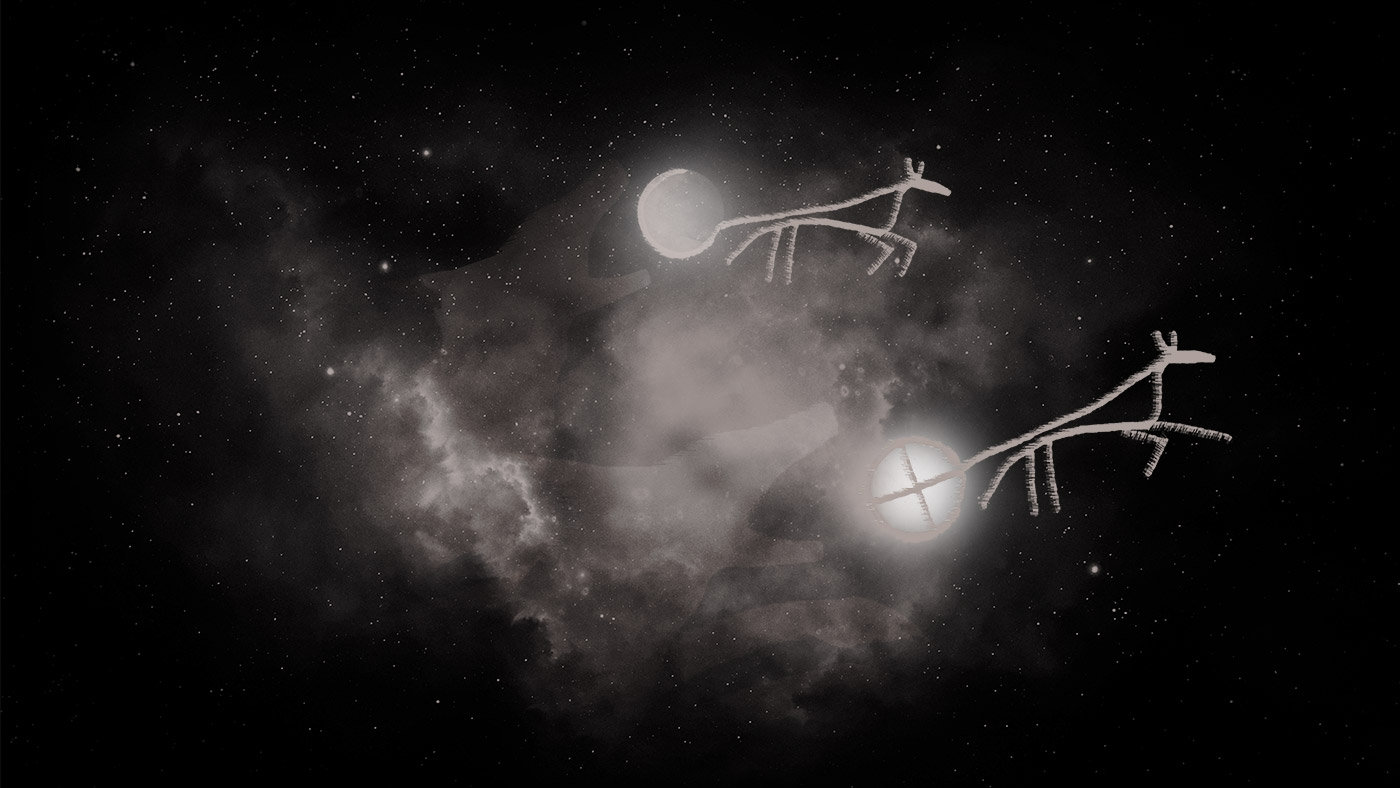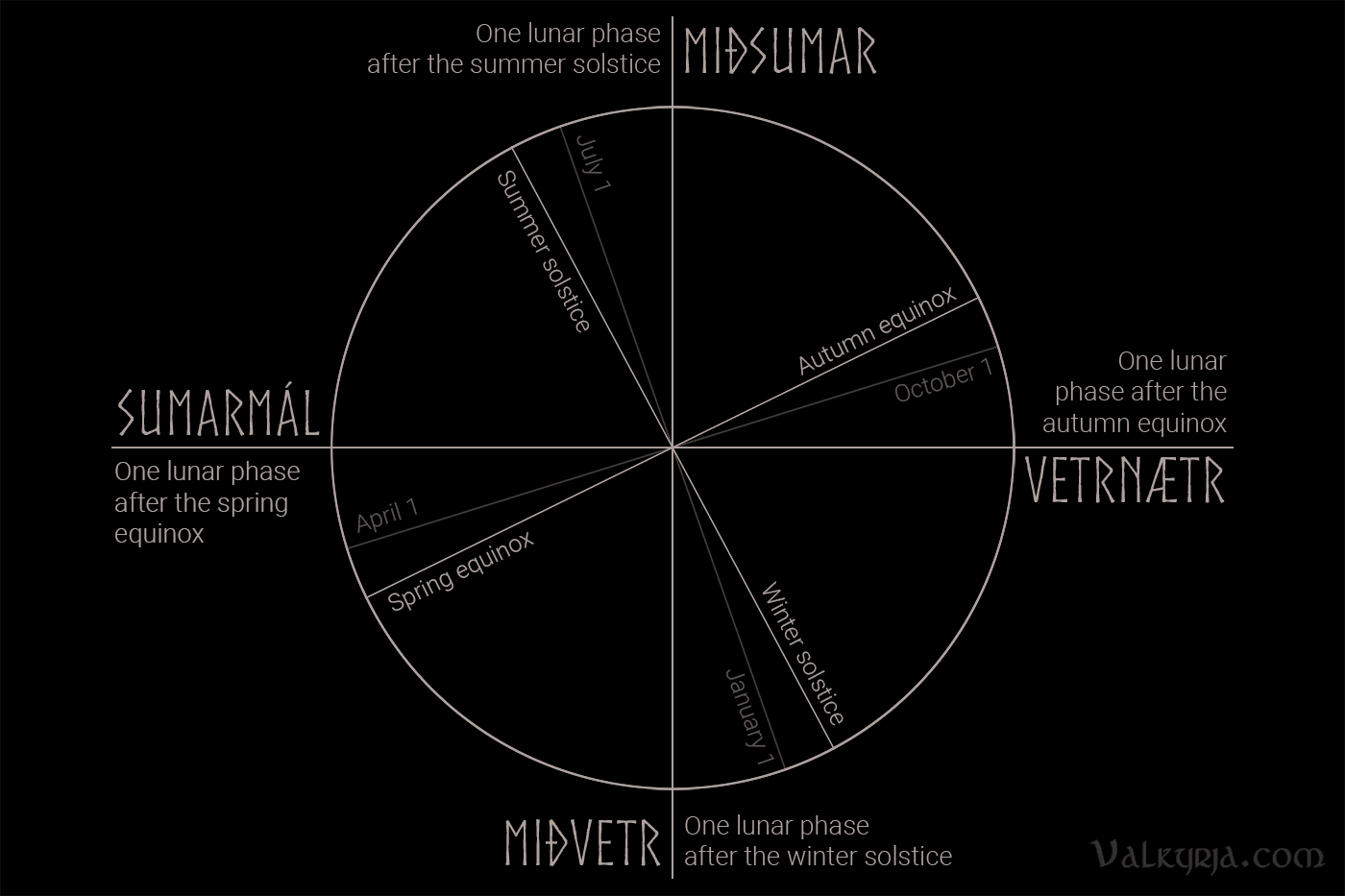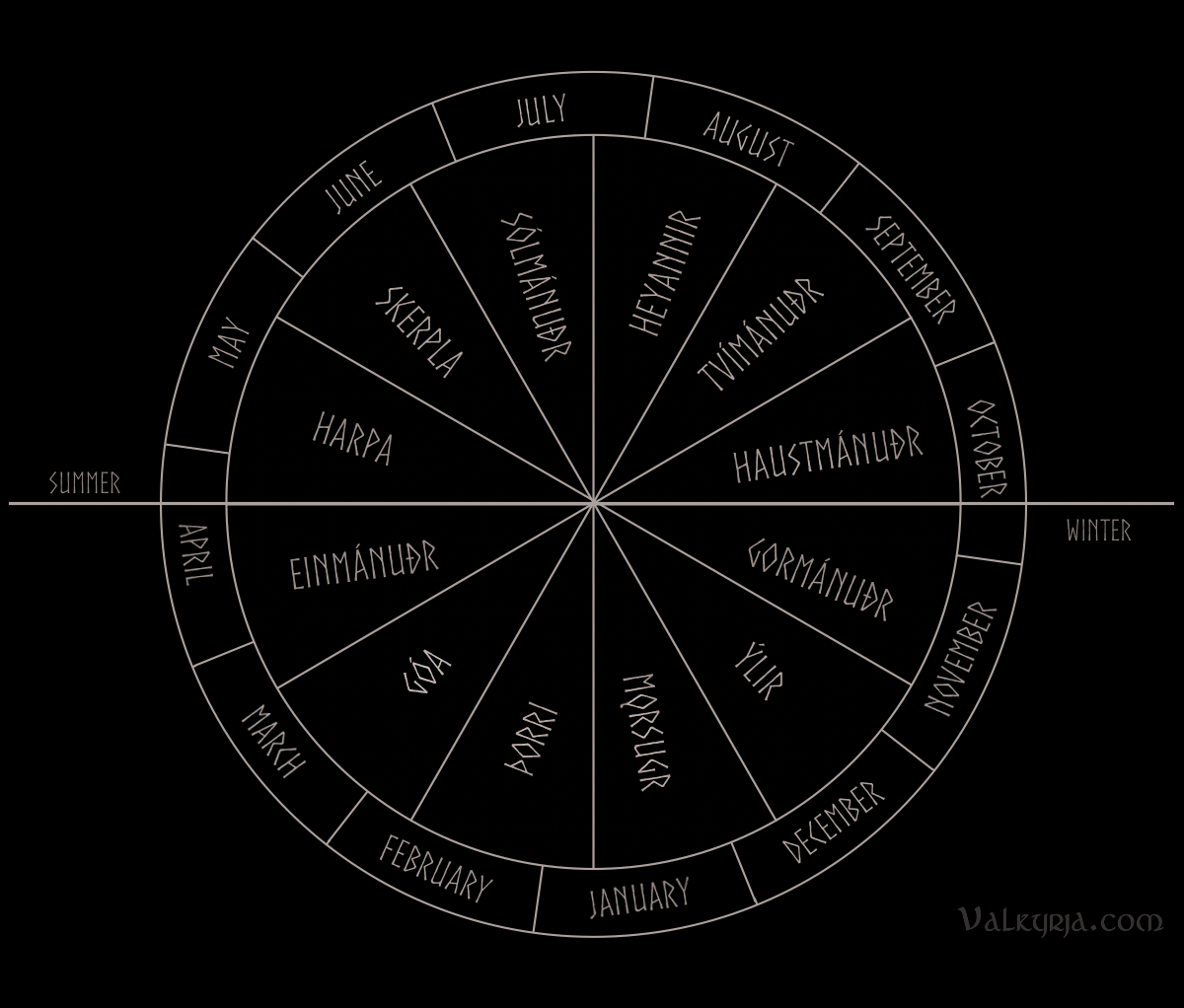|
|
||||||||||||||||||||||||||||||||||||||||||||||
During the Viking Age, the year was divided into two main seasons, summer and winter. Each season consisted of 6 months (lunar phases) each. And according to the Old Norse calendar, we have just entered the third month of the summer half-year. What a great time to be alive! 🌱 
But wait a minute... 12 lunar months x 29.5 days. How does that even work? Below is a revised and expanded version of one of my most read blog posts from many years ago, explaining the old calendar and how it is believed to have been used during the Viking Age. Background and context... The evidence base of pre-Christian calendars in the Nordic countries is relatively scarce compared to how much is known about the systems that were adopted with the Christianization. To make matters more difficult, the literature we do have tends to be somewhat conflicting, which makes reconstructing the Old Norse calendar complicated.While this field of research was buzzing in the first half of the 1900s, it lost some relevance after the second world war (1). This left the existing and ambiguous literature unchallenged—until more recent authors picked up the threads and started tying up some loose ends. Notably, Nordberg, a historian of religion, wrote the book "Jul, disting och förkyrklig tideräkning" which provides an extensive overview of information and interpretations (2). The closest we get to contemporary sources are mainly Eddic poetry and various other medieval Icelandic manuscripts from the early 1200s. These provide us with rich descriptions of time-reckoning from a mythological perspective, as well as lists of months and even descriptions of how the year was regulated. But as Nordberg points out, such Nordic evidence is found in contexts where the reader was expected to understand the underlying meaning and expressions used, without needing additional explanations. I think that also helps explain why modern misconceptions about celebrations being centered around the solstices and equinoxes are so common and hard to get rid of, even among those interested in living history: If midwinter/midsummer means the same as winter/summer solstice to the modern reader, they will be happy to assume that the writer of the historical text had the same perspective. The perception that Yule was celebrated at the winter solstice in honor of the sun was a common assumption among researchers from the 17th century that lived on into the 20th century (2), and is still reinforced through popular science articles as well as modern Ásatrú organizations and historical reenactment groups. Many people seem eager to pile Scandinavian religious traditions and feasts into one big pagan sun‑worshipping culture. It does seem intuitive, and it would make it all so much simpler, wouldn't it? But it wouldn't make it any more true. A lunisolar year As mentioned above, the Old Norse calendar was essentially divided into two seasons: the summer and the winter half-year. Each season consisted of six months, or lunar phases, probably counted from new moon to new moon (2).But while there are 365 days in a solar year, a lunar phase consists of about 29,5 days and a lunar year with 12 months will therefore be 11 days shorter. This means that the start of any given lunar month will continuously take place 11 days earlier the year after, causing a displacement in relation to the solar calendar... We see this in purely lunar calendars such as the Islamic one, where the same month occurs in different seasons over the course of the years (2). In geographical areas where the seasons differ significantly, like here in Scandinavia, this would be largely impractical! The names of the Old Norse months indicate a close relation to seasonal changes and tasks in the Viking Age farming society, which further underlines the need for (relatively) fixed months.
This also requires a leap year system. Nordberg describes such a system where a 13th intercalary month was inserted every three years or so. The winter solstice served as the governing time point for this, as it was set to take place in the same month every year. To be precise: If the new moon of the second Yule month took place less that 11 days after the winter solstice, the additional 13th month was added to the following summer, making sure that the new moon month would not occur before the winter solstice in the following year. Medieval Icelandic sources point to another leap year system, but we will get back to that later. The sun and moon in Norse mythology Evidence for the Norse lunisolar year is for example seen in this stanza from Vafþrúðnismál (3) concerning the origin of the sun (sól) and the moon (máni), and how time is measured by their movements over the sky:
Notice the expression ártali—the counter of the years, a term that occurs in several sources where it is also used for the moon specifically. The time period ný ok nið (waxing and waning moon) is furthermore found in sagas and provincial laws as a function to measure time. The beautiful stanzas below from Voluspá (4) describe how the Gods gave the sun and the moon paths and purpose during the creation of the world:
The sun and moon may be envisioned mythologically and iconographically as traveling over the sky in wagons, ships, or by horse (2). In Norse mythology the sun and the moon are pulled across the sky in horse-drawn carriages driven by the personifications Sól and Máni. According to Gylfaginning (5) they were appointed these roles by the Gods as a punishment of their father, and are chased by the wolves Sköll "mockery" and Hati "he who hates". During Ragnarok the wolves will catch up with them and swallow them whole (5, see also 6). 
The four quarters and main blóts of the year The natural split between summer and winter as opposing halves is apparent in Medieval sources and can still be seen on Norwegian calendar staffs (the primstav) that have one side for each of the two seasons. But the annual cycle of the year was further broken into quarters, which marked the annual festivals and celebrations (2, 7) or in Old Norse blóts. These were not centered around the solstices and equinoxes, but as we will see, their timing was certainly related to them.The year began with the fall blót during the so-called Vetrarnætr (Winter Nights), at the start of the winter half-year in our present-day October. The Yule blót was held at Miðvetr (Midwinter) in our month of January. The spring blót Sumarmál marked the first days of the summer half-year during our April, and finally the Miðsumar (Midsummer) took place in what is our July. The celebrations seem to have lasted for a three day period, that were later standardized into one day (2, 7). Because of the connection to the full moon, the celebrations were movable. For example, the Yule blót was most likely celebrated at the full moon of the second Yule month. That is, the full moon after the new moon following the winter solstice. The possible interval for this in the modern Gregorian calendar is between Jan 5th at the earliest and Feb 2nd at the latest (this year it was Jan 28, and next year it will be Jan 18th). This coincides with the time for the Yule blót as described in the saga literature (2), celebrated at midwinter, the coldest time of year, not at the winter solstice. The reason for the "skewed" division of the year was probably due to the climatic conditions in the Nordic region, as the warmest and coldest time of year occur later than the solstices and equinoxes. 
For more details, check out my separate blog post dedicated to this topic: The four main blóts (feasts) of the year. The names of the months The two main seasons of summer and winter consisted of six months each. The names of the individual months are listed in Medieval Icelandic sources, although many of them are almost certainly much older (2).Rím I from the 1100s and Bókarbót from the 1200s (8) list the six winter months (left column below). Some of the months have complementary or different names that are used in other sources, mainly Skáldskaparmál (10) which also lists the six summer months (listed on the right). A couple of the summer months have additional names that are only attested in more recent sources from the 1600s (Harpa and Skerpla), although it is possible that these also have a much older origin (10).
But why has the knowledge about the winter months been better preserved than the summer months? It might be that the month system was mostly used during the winter half-year, while the work year and its tasks during the summer was more strongly rooted in a week system (2). This could also explain why the names of the summer months have several variations that seem to be local and related to the economic and ecological year, while the winter months seem to be more universal, and to have older names with more abstract or uncertain semantic meaning. Another preserving factor for the names of the winter months may also have been that they coincided with the Christian holidays that were later introduced, which helped ensure their survival. Medieval Icelandic calendar tradition As Christianity came and spread across Scandinavia, the old way of measuring time was replaced by the Julian calendar around the mid 12th century (2). But in Iceland specifically, the Christianization was a peculiar and gradual process (11-13). The old names of the months remained in the Icelandic language much longer, and the Latin names were not adopted into the common tongue until the late 18th century (14).In fact, they still exist to some degree today, much due to their link to folk tales and traditions such as the Þórrablót which is still celebrated across and regardless of religious beliefs. Most modern Icelanders will also know that the men's day is celebrated on the first day of Þorri while the women's day is on the first day of Góa, and the first day of summer remains a public holiday falling on the first day of Harpa. In Medieval Iceland, priests, law-speakers, policy makers and other administrators of the Icelandic society tried to synchronize the different calendar systems that were in use, resulting in a rich material of calendar texts. But this was mingled with basic principles from the Christian church calendar (2), and as a result, it is not clear how this system compares to the pre-Christian system in Iceland. I have drawn it up here as compared to the modern Gregorian calendar (15): 
Since that accounts for 360 days, four additional days were added to the third summer month, just before the midsummer. But with 364 days there was still need for a leap year system. So, to make up for the divergence with the solar year, an additional week was added at the end of summer every 7th year, called sumarauki (literally, "summer addition"). This is attested in a paragraph in Íslendingabók (the book of Icelanders) that can be translated to: The wisest men of the country observed from the motion of the sun that the summer moved back towards the spring. But there was no one to tell them that there is one day more in two misseris than you can count using whole weeks, and that was the reason. There was a man called Þorsteinn surtr. When they came to the Althing he walked up to the Law-hill and proposed that to every seventh summer a week should be added, to see how that would work. The proposal was implemented in law. (11). 
To sum it all up... In short, the calendar used in Scandinavia during the Viking Age was a lunisolar calendar, where the lunar months were tied to the solar year based on the time of the winter solstice. The solstice thereby served as a governing time point, but apart from that, the solstices and equinoxes did not really have much significance. The year was divided into two main seasons—summer and winter—each containing six months. It was also divided into four quarters, each beginning about one moon phase after the solstices and equinoxes. This was based on the climatic conditions in the Nordic region, and was also the time for the main blóts or celebrations of the year.
References:
Music: Wardruna - Solringen # Comments |
 
|
|||||||||||||||||||||||||||||||||||||||||||||
|
||||||||||||||||||||||||||||||||||||||||||||||
